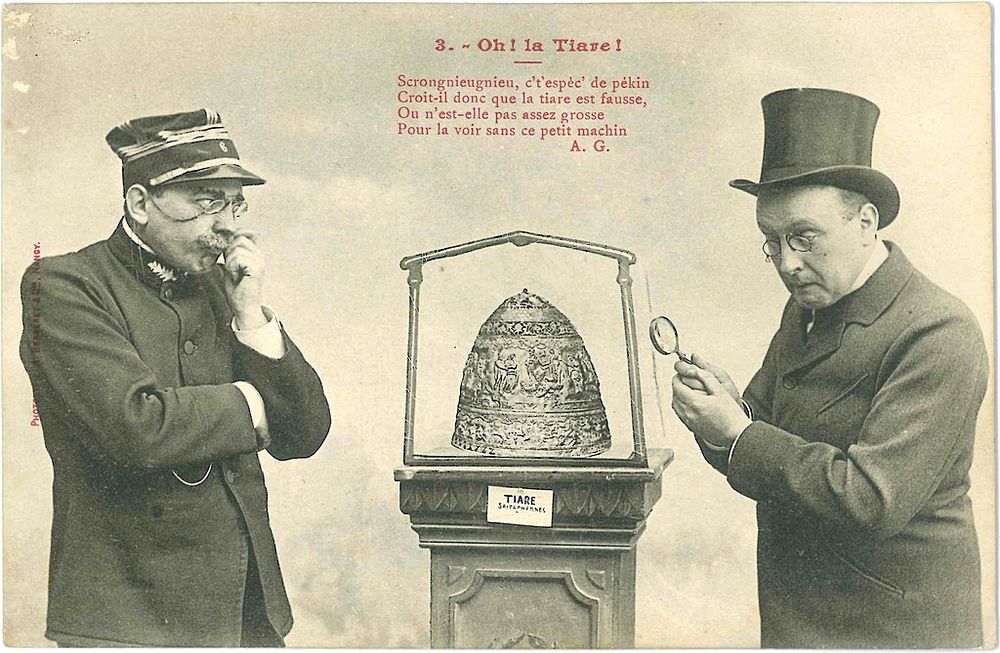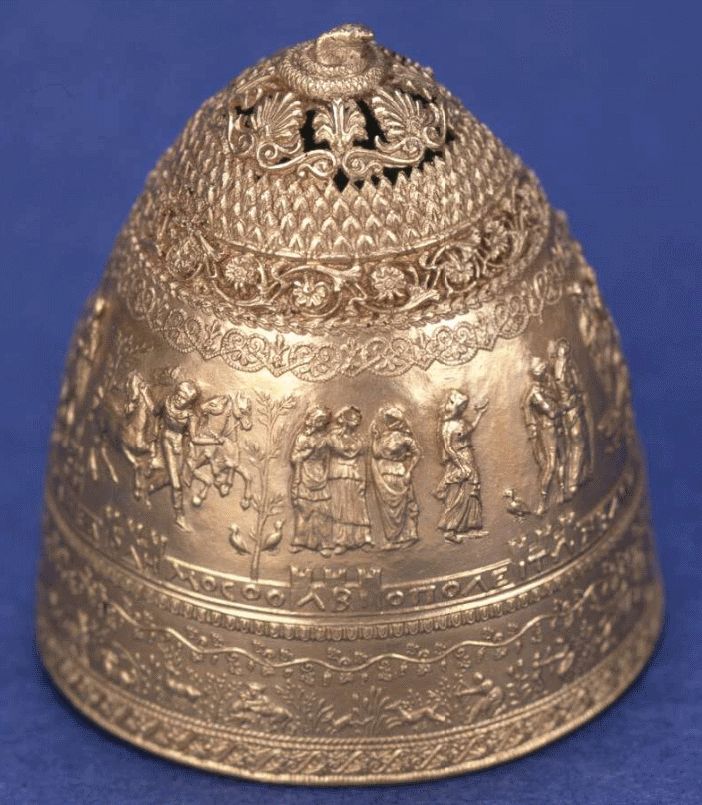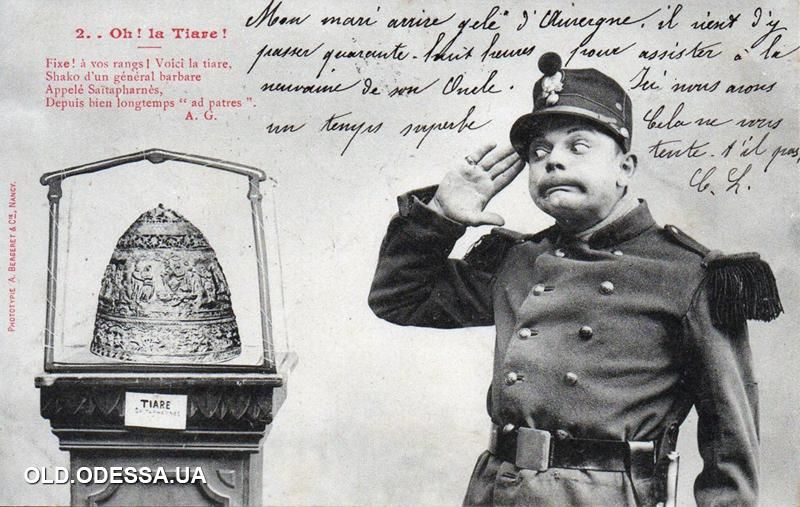For the better part of a decade, the widely celebrated and esteemed Louvre Museum of Paris proudly displayed a supposedly ancient tiara made of solid gold. Experts at the Louvre identified it as belonging to the Scythian king Saitapharnes who ruled sometime in the 3rd century BCE. An inscription on the tiara mentioning that it was a gift from Olbia, a Greek colony on the Black Sea coast, to King Saitaphernes left no doubt about the item’s authenticity and great age. But later it became clear that the tiara's new owner had been a little haste in acquiring the item. The exhibit is now locked away in storage—an embarrassment, for the tiara was proved to be a hoax perpetuated by two Russian art dealers.

A postcard ridiculing the Louvre’s dubious purchase. Photo: Wikimedia Commons
The story of the tiara began in 1894 in the Russian city of Odessa. Two art dealers Schapschelle Hochmann and his brother Leiba approached a skilled goldsmith Israel Rouchomovsky and convinced him into making a dome-like crown out of gold for an archaeologist friend of theirs. Rouchomovsky was unfamiliar with Greek mythology and so the men provided the artisan with books of drawings of ancient finds and details from recent excavations to aid his design.
The finished product stood 7 inches tall and weighed a little more than a pound of solid gold. The lower part of the tiara was decorated with scenes of Scythian daily life, while an upper wider band showed episodes from Iliad including Agamemnon and Achilles quarreling over Briseis. An inscription ran around the tiara reading: “The council and citizens of Olbia honor the great and invincible King Saitapharnes”. The text was an allusion to an episode dating to the late 3rd-century BCE or early 2nd-century BCE, where King Saitapharnes had besieged the Greek colony of Olbia and was convinced to leave the city in peace only through the offering of expensive gifts.
Rouchomovsky handed over the crown to the Hochmanns, collected his commission, and didn't think any more about it.

Tiara of Saitaferne. Photo: British Museum
Several months later, the Hochmann brothers went to Vienna to exhibit some of the “newly discovered” Russian antiques that a group of Crimean peasants supposedly found in a field. At that time, Greek and Scythian artwork from Russia were highly coveted by European museums as a result of magnificent finds from sites such as Kul Oba (1830), Chertomlyk (1863), and Seven Brothers (1875-1878). Among the finds exhibited was the tiara that Rouchomovsky had unknowingly forged.
The Imperial Court Museum in Vienna and British Museum had some reserves and both passed on the tiara, but the Louvre jumped at the opportunity to purchase it, paying 200,000 francs for it. Perhaps appropriately, the deal was signed on April 1, 1896.
Shortly after the Louvre acquired the tiara, questions about its origins arose. German archaeologist Adolf Furtwängler noted many stylistic problems with the tiara's design and questioned the artifact’s pristine condition. But the Louvre rebuffed, accusing the archeologist’s motives “to have been dictated by spite“—his being German and the museum being French. For six years, a battle ensued between the Louvre and the Parisian press.

Israel Rouchomovski
News of the tiara eventually reached Rouchomovsky, who was alerted of the possible fraud by his friend and associate named Lifschitz, to whom Rouchomovsky had shown the piece in passing. Lifschitz also wrote a letter to the editor of the the French newspaper Le Matin claiming to have witnessed Israel Rouchomovski making the tiara. This letter was published in 1903.
Rouchomovsky was indignant for having been cheated. He traveled to Paris and presented himself to the Louvre. He explained how he had been tricked into making a phony crown. He even pointed out the exact books the Hochmanns gave him, and described to the Louvre how he made it in three parts and soldered them together. Still unconvinced, the museum provided Rouchomovsky with some gold and asked him to do his best. It was only when the artist had reproduced a portion of the crown, did the museum realize that they had bought a dud.
Later, the World Today wrote a scathing article in 1907:
There are a lot on indentations on the tiara and these furnish a comical note in this affair. They were supposed to have been caused by the falling of stones of the mouldering tomb. These stones certainly possessed a rare and discriminating appreciation of art, since they had avoided falling on any of the numerous figures in relief, but had dented in most of the smooth spaces. What was more, unless the worthy Scythian potentate had turned around a few times in his tomb one could not explain why dents were found on all sides of his tiara. However there had been no miracle, the bumps and indentations were made by using alternately the ends of a common ballpane hammer.
This story attracted a lot of public attention. Merchants sold postcards, souvenirs and copies and tiaras. Cartoons were drawn about it and sang in cabarets.

A satirical postcard. Photo: Wikimedia Commons
The Louvre still owns the Tiara of Saitapharnes, though it is no longer on display. In 1954, the tiara was included in a "Salon of Fakes" at the Louvre along with eight Mona Lisas. The tiara has been borrowed a few number of times by other museums and exhibited. There are two copies of the tiara, one each at the British Museum and the Tel Aviv Museum of Art.
The tiara fiasco made Rouchomovsky a celebrity. The Odessa master was introduced to the wealthiest Jewish banker and art collector of Paris, Baron Edmond Rothschild, who immediately ordered a number of objects from him. Other works earned him a Gold Medal at the Paris Salon of Decorative Arts. In 2014, a memorial plaque was unveiled on the wall of Rouchomovsky’s workshop in Odessa where the tiara was forged.

Memorial plaque to jeweler Israel Rukhomovsky in Odessa. Photo: Mitrius/Wikimedia Commons
References:
# Saitaphernes' Golden Tiara, Archaeology
# The scandal of the antique gold tiara sold to the Louvre Museum. A fake artefact “made in Odessa, The Odessa Journal
# Wikipedia



Comments
Post a Comment